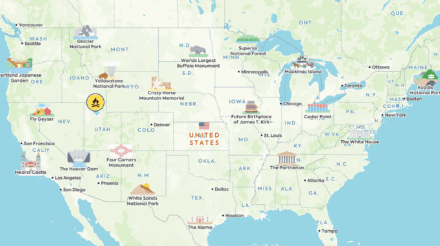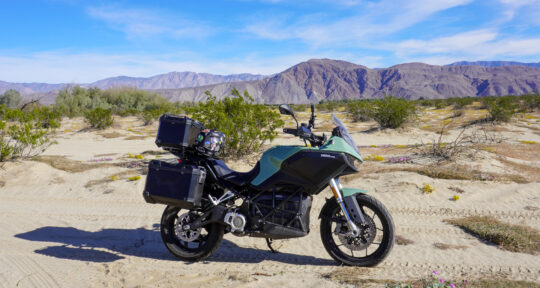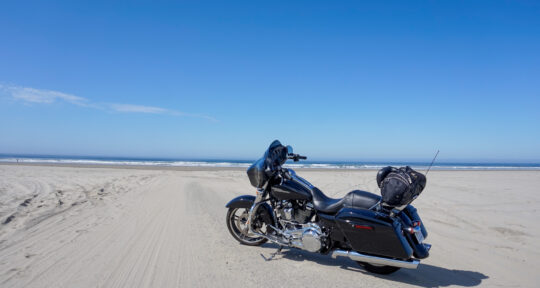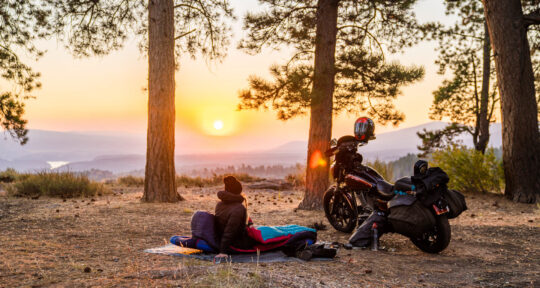If you ask me, there’s no better way to see the United States than to do it Easy Rider-style: by going on a motorcycle road trip. Traveling on two wheels means a much more up-close connection to your surroundings than a car can offer. You’ll smell the wildflowers on the side of the road, hear rushing rivers and birdsong, and feel every curve in the road through your entire body.
But roadtripping by motorcycle also comes with some unique challenges. As someone who’s ridden a motorcycle on multiple continents, through all sorts of weather and road conditions, I’ll be the first to admit that it’s not always smooth sailing.
To make the journey as safe, comfortable, and fun as possible, here are some things to keep in mind as you prepare for your epic two-wheeled adventure.
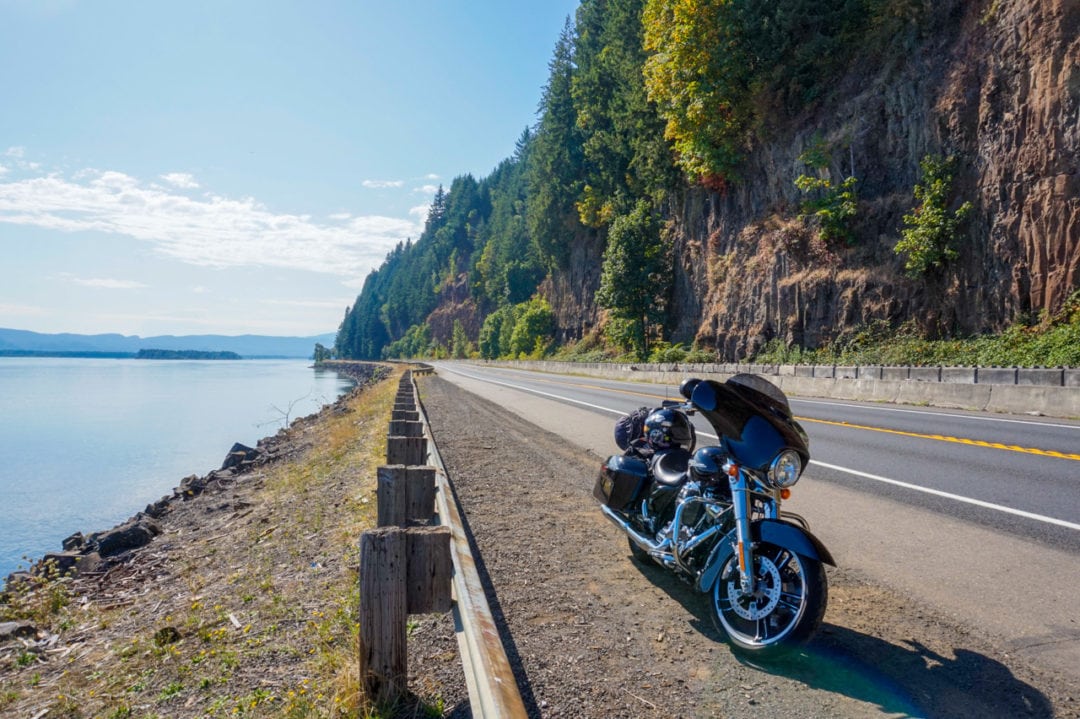
1. Choose the right motorcycle
Whether you’re riding your own trusty steed or renting one for the trip, it’s important to make sure you have the correct motorcycle for your height and weight, as well as the type of riding you’re planning on doing.
You’ll be seated in the same position for hours on end, so it’s important that your bike accommodates this. Make sure things like handlebars, footpegs, backrests, suspension, and seats are all properly set up and adjusted for your height and riding position. Added accessories—like highway pegs for stretching out your legs—can also help increase comfort.
Adventure motorcycling is growing in popularity as a major player enters the field
You’ll also need to make sure the motorcycle has enough built-in storage or room for added luggage. One of the main differences between traveling by motorcycle and car is the limited storage space, so be smart about what you pack and how you pack it. Does your bike have saddlebags? Great! Are they also waterproof in case of rain, and lockable in case you need to leave the bike unsupervised for any reason? Even better. These are good things to confirm ahead of time.
And finally, decide what kind of riding you plan on doing. Are you going off-roading or sticking to paved roads? Will you be going mostly straight or hitting up the twisties for some canyon carving? What is the longest stretch you’ll travel without encountering a gas station? If something happens and you drop your bike, will you be able to pick it up yourself (keep in mind that some larger motorcycles can weigh up to 900 pounds)? The answers to these questions should help you narrow down whether you need a touring bike, cruiser, adventure bike, or something completely different.
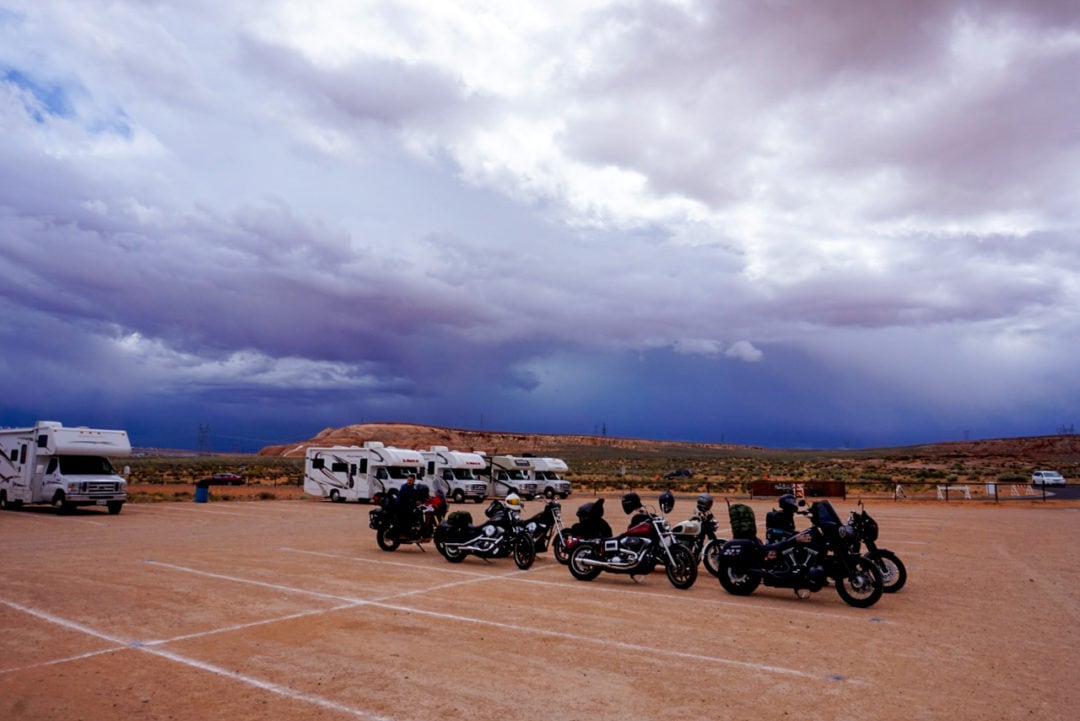
2. Pack for all-weather travel
Riding a motorcycle means being completely exposed to the elements. You’ll feel every wind gust, rain drop, and temperature change in a way that someone in a car never will.
Even if you’re not traveling cross-country, temperatures can vary widely depending on elevation and time of day—even within the same state. You may need to prepare for riding through everything from snow to rain storms to desert heat. Riding in heavy wind or being very hot or cold for a long period of time can be physically draining, and sometimes even dangerous, so it’s important to properly prepare for all likely scenarios (and it can’t hurt to prepare for some unlikely ones as well).
A 16,000-mile bucket-list motorcycle road trip through 26 states
Pack layers—that way you can easily bulk up or strip down as needed along the route. This is important not just for regulating temperature, but also for safety in case of an accident. At least one of the layers should be protective—look into gear with built-in armor and abrasion-resistant fabrics (such as Kevlar or Dyneema).
A rainsuit, waterproof gloves, and boot covers are going to be lifesavers in the event of heavy rain. Make sure to keep these items easily accessible, so you can quickly pull over and rainsuit up if the weather turns sour.
If you’re traveling during the winter months, consider investing in some heated gear. The best time to buy heated gear is during summer, when many brands tend to run sales. I promise you won’t regret spending the money a few months later, when you’re able to plug in your jacket, pants, gloves, and boot liners and stay toasty even in freezing temperatures.
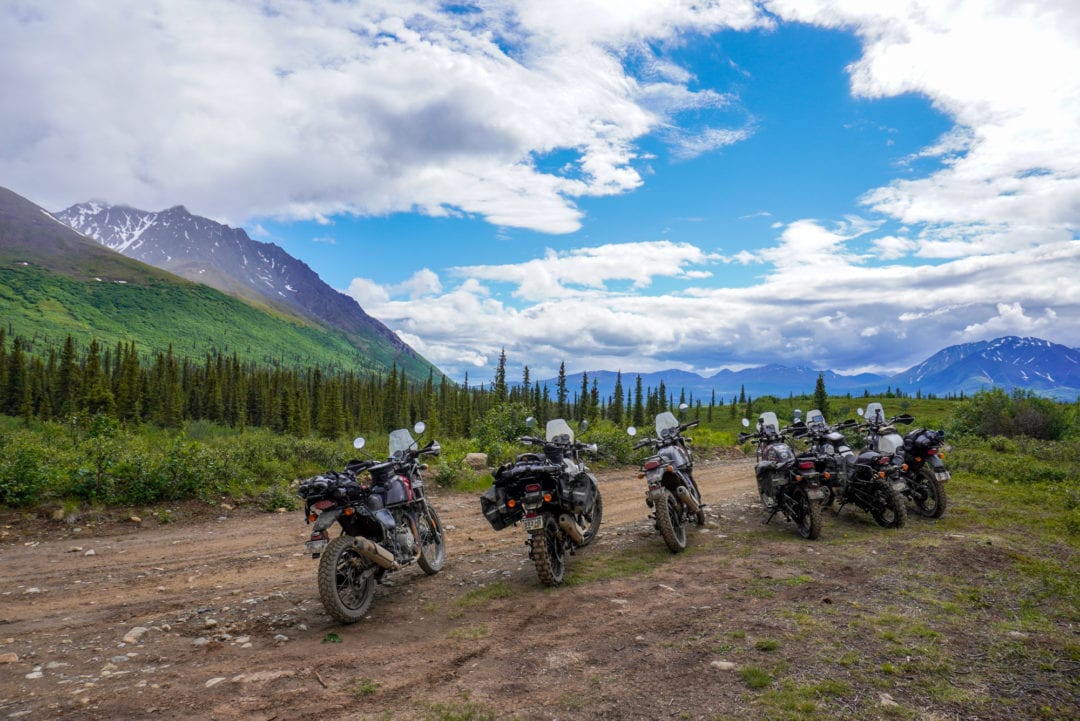
3. Take frequent snack breaks
Spending long hours on a motorcycle tends to make everything hurt at the end of the day. One way to help combat the worst saddle sores and muscle ache is to take frequent breaks. Don’t just make 5-minute gas stops every 100 miles—you’ll regret it the next day. Instead, make a habit of getting off the bike and stretching every time you stop. Take at least 15-minute breaks and walk around for a bit if you’re able to.
8 epic motorcycle routes with nearby campgrounds
Carry plenty of water and snacks to stave off dehydration or blood sugar drops. If you’re riding during the hottest summer months, you may need to stop more frequently than normal to be able to stay hydrated. Some people even ride with a hydration pack to be able to drink water without stopping. A quick snack between meal times can also help you stay alert and energetic during long rides. Food items such as apples, nuts, energy bars, and dried fruit are easy to pack and tend to keep well even in changing temperatures.
It’s tempting to just quickly gas up and get back on the road, but make a point of getting off the bike to stretch, drink water, and eat something every time you come to a stop. It will make the entire trip all that much more enjoyable.
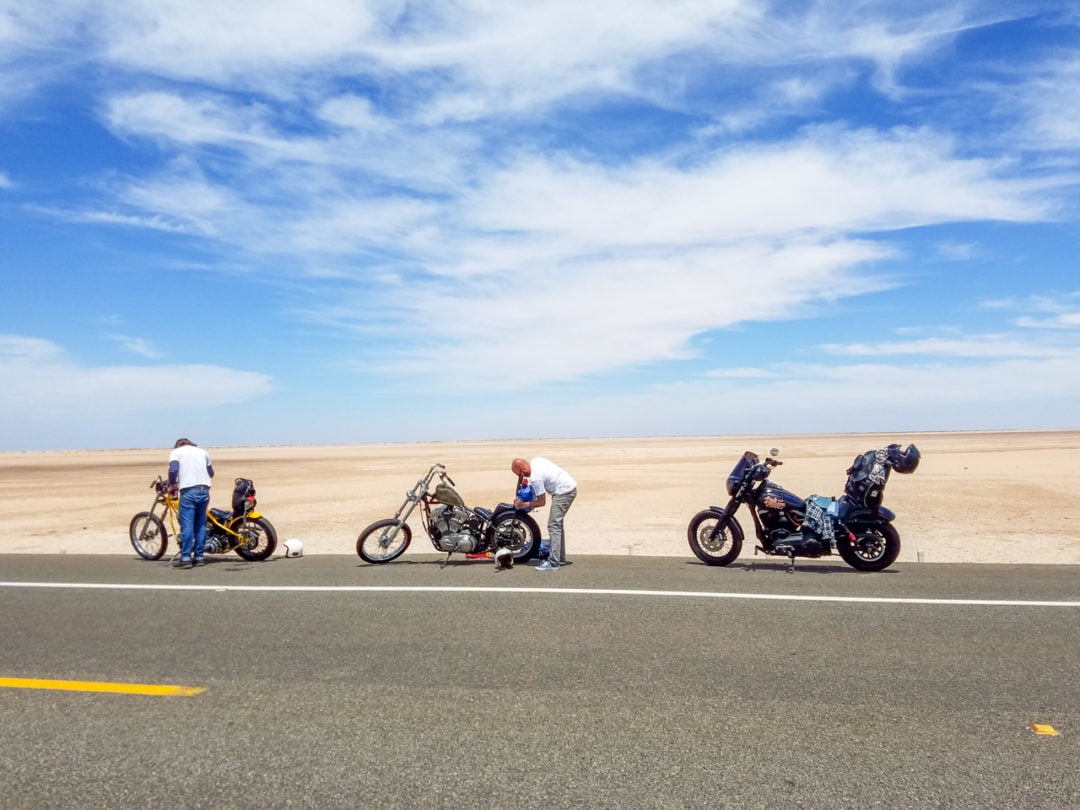
4. Bring tools
The most reliable thing about motorcycles is their unreliability. It’s always wise to hope for the best while preparing for the worst. Consider getting your bike serviced by a professional before heading out on a longer trip—and then do it again when you return. Even if your bike is newer or recently serviced, make sure to at least check your brakes, tires, lights, and fluid levels, and tighten any loose bolts.
Long-haul road trips often require continuous maintenance—tires wear out, parts rattle loose, and oil may need to be refilled. It’s always a good idea to carry a basic tool kit for any roadside fixes, but remember to double check that you have the correct tools for your bike. Some motorcycles require metric tools while others use imperial sizes. If you’re not sure which tools you need, see if your specific motorcycle manufacturer sells pre-assembled tool kits—that’s usually a good place to start.
Endless miles of gravel: A solo motorcycle ride from coast to coast on the Trans America Trail
Consider also carrying some spare bulbs, fuses, and spark plugs. Other items that can come in handy in a pinch include zip ties, extra bungee cords, electrical tape, a tire repair kit, a tire pressure gauge, locking pliers, and a flashlight.
Even if you’re inexperienced when it comes to working on motorcycles, many quick-fix roadside repairs can be accomplished with the help of YouTube videos. If all else fails, make sure your insurance or roadside assistance service covers motorcycle towing.
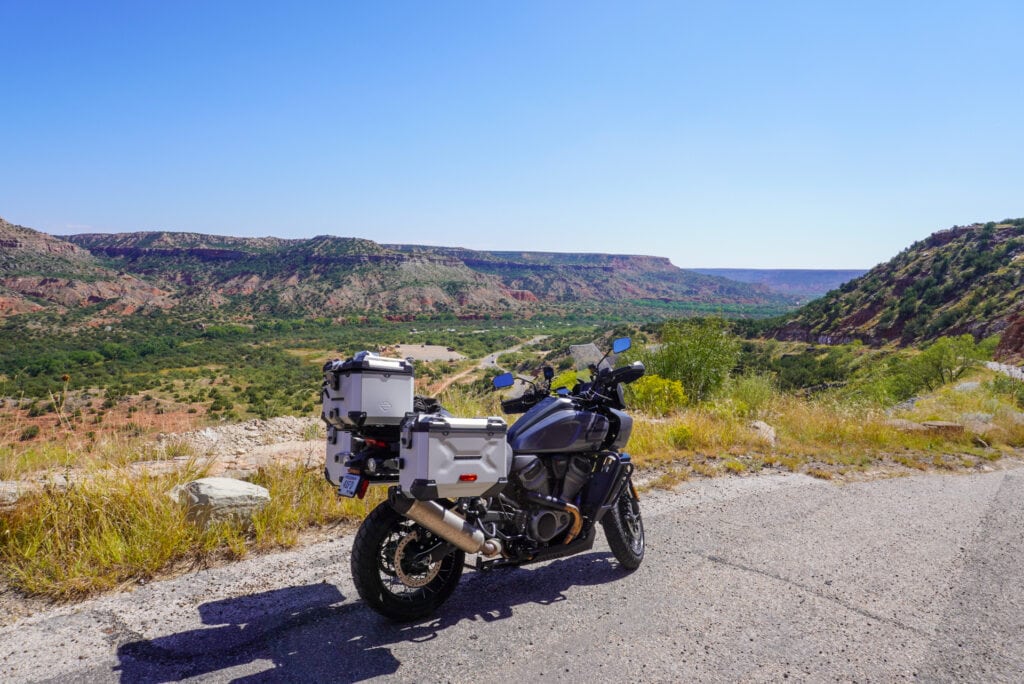
5. Have a backup plan
This is true for all travel, but when it comes to roadtripping on a motorcycle, it’s absolutely crucial to have a backup plan in case something doesn’t go according to the original plan. You may encounter inclement weather or changing road conditions that make it difficult to continue in your planned direction. Road construction can place you on an unexpected dirt road when the paved highway you’ve been traveling on for miles is suddenly replaced by gravel. (There’s nothing I personally dread seeing more than the ominous “Motorcycles Use Extreme Caution” road sign.)
I can’t tell you the number of times I’ve had to completely re-route an entire trip at the last minute—including bypassing entire states—just because of sudden changes in weather. It’s important to be able to go with the flow and adjust your expectations when you’re roadtripping on a motorcycle—or you may end up being very uncomfortable for a very long time.
Riding cross-country on a motorcycle is miserable—and the most amazing thing ever
But here’s the good news: Sometimes having to veer off your planned path ends up being the best thing that happens during your entire trip. An unplanned detour can lead you to things like scenic roads, wildlife sightings, cute eateries, or bizarre roadside attractions that you wouldn’t have otherwise come across. So, in short, have a plan—but be prepared to drop it at any time and go a completely different route.
Frequently asked motorcycle road trip questions
See below for answers to the most common questions about motorcycle road trips.
How many miles you can ride a motorcycle in a day depends on things like your comfort level, weather, the kind of bike you’re riding, and what type of terrain you’ll be traversing. On a comfortable motorcycle with a large gas tank, a determined enough rider can ride up to 1,000 miles in a 24-hour span—this is commonly referred to as an Iron Butt. However, it’s more realistic for the average rider to travel between 200 and 400 miles in a day. This should give you enough time to stop for sights, meals, and activities along the way.
There’s no one motorcycle that’s perfect for every road trip and rider. When picking a bike for your trip, consider things like your height and weight, riding style, experience, and what type of riding you’ll be doing. For example, a big touring bike might be the most comfortable choice if you’re planning on doing a lot of highway riding—but consider whether you’re able to move it around at low speeds and in and out of parking spots.
Planning a long distance motorcycle trip is similar to planning any other road trip. Pick your destination and any stops you want to make along the way (Roadtrippers makes this part really easy)—but be prepared to be flexible. Traveling by motorcycle means that things like inclement weather will have a much greater impact on you than if you were in a car, so it’s a good idea to always have a backup plan.
To stay comfortable on a long motorcycle ride, make sure your bike is set up for your body type and riding style, and wear the proper gear for the climate and season. It’s also a good idea to take frequent breaks to stretch, hydrate, and have a snack or meal. Some motorcycle modifications that can help you stay more comfortable include a windshield or fairing to block the wind, highway pegs to allow you to stretch out your legs, and an upgraded touring seat.
On a long motorcycle trip, make sure you pack enough layers to keep you comfortable through changing temperatures. Depending on your route and the time of year, you may need to bring rain gear, heated layers, or gear with good airflow. Always bring a tool kit and some spare parts so you don’t get stranded on the side of the road. If you’re camping along the way, you’ll also need camping gear—backpacking gear is typically great for motorcycle trips, as it’s lightweight and doesn’t take up much room in your bags.

